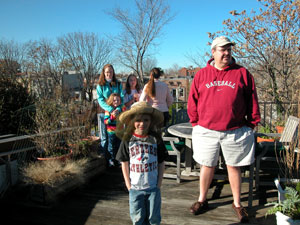
My daily family life is usually made up of Sam, my bees, my pets, and a beekeeper or two. This Thanksgiving, however, our table was set for 16! Yet another reason for thanks: we did it potluck style. And the third reason: people did not want to head home the next day before visiting with the girls.
Usually, no one under the age of 10 is allowed on the roof, mostly because I am too distracted by the bees to keep toddlers from toppling off the edge. Since all the parents were just as interested as the kids this time, solemn oaths were performed concerning child retention and my inability to cope with the guilt of any untimely demise(s), and the parents looked after their kids when we tromped up the spiral staircase. This picture shows pre-bee family. Up front, in a spare veil, is Duncan, to his left is Uncle Joe, and behind are the female cousins (for now).
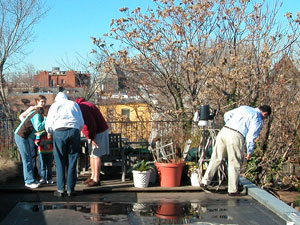
Now you see us all gathered around a honey frame I took from Wilde in order to show everyone where the sweet stuff really comes from. Interestingly, you can see that the only young one who is in danger of falling off the edge is my husband. My cousin Anna took these pictures.
It was hard to actually show them bees, because the day was too cold for them to fly in any numbers. Happily, when I popped the top, the bees were down low in the hive (where they are supposed to be at this time of year). If they are up top, it's a sign that they are low on stores, and have already tapped into the stuff that they placed farthest from their starting point in the bottom box.
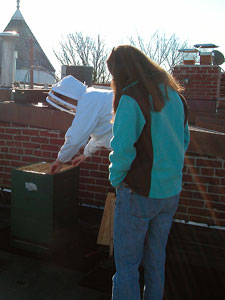 Both of my cousins, Maria (shown here) and Anna (taking the picture) are teachers, and they immediately expressed interest in the bees as a learning tool for kids (I guess it's genetic for us to immediately decide "the kids gotta hear about this!") As I went back to put away the honey frame, Maria came along to take a peek. Note the lack of veil, fear, gloves, etc. She even leaned over and took a good long sniff of wonderful bee essence. One of my favorite things, and something missed in winter, is the warm sweet cloud of scent that wafts up whenever you open a beehive. Now she knows what I mean, too.
Both of my cousins, Maria (shown here) and Anna (taking the picture) are teachers, and they immediately expressed interest in the bees as a learning tool for kids (I guess it's genetic for us to immediately decide "the kids gotta hear about this!") As I went back to put away the honey frame, Maria came along to take a peek. Note the lack of veil, fear, gloves, etc. She even leaned over and took a good long sniff of wonderful bee essence. One of my favorite things, and something missed in winter, is the warm sweet cloud of scent that wafts up whenever you open a beehive. Now she knows what I mean, too.
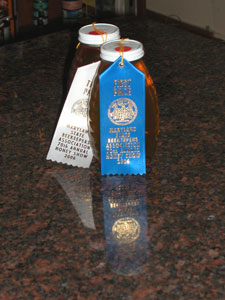 Blue comes in a coupla forms, actually. First, something I meant to mention this weekend: on Saturday, we had the state beekeeping association meeting, complete with a mini honey show. After scoping out whether there were any ants present, the judges gave the monastery honey a first in the beginner category for light color. The rooftop honey got a third for medium color in the same category. It is beginning to granulate, actually (more reason to eat it right away). This makes my collection of ribbons include a second (in a class of two), two fourths (in a class of four and of five), a third, and a first – a complete set, the last two actually meaning something. Interestingly, the wife of the judge who gave me the fourths said that
Blue comes in a coupla forms, actually. First, something I meant to mention this weekend: on Saturday, we had the state beekeeping association meeting, complete with a mini honey show. After scoping out whether there were any ants present, the judges gave the monastery honey a first in the beginner category for light color. The rooftop honey got a third for medium color in the same category. It is beginning to granulate, actually (more reason to eat it right away). This makes my collection of ribbons include a second (in a class of two), two fourths (in a class of four and of five), a third, and a first – a complete set, the last two actually meaning something. Interestingly, the wife of the judge who gave me the fourths said that  In August of last year, roofers next door outed the bees to our south-side neighbors, resulting in just 4 months of undetected beekeeping. Luckily, those neighbors are a little paranoid, too; they also thought the bees were cool, and decided to keep the matter to themselves. Then, this Spring, the north side neighbor got a new roof, and I became really worried, because Kathy is a normal, well-adjusted person with children and her reactions would therefore be alien to me. But it turns out that her roofers never told her, and as a result I outed myself last month (sort of) and she was kind of happy about the whole thing.
In August of last year, roofers next door outed the bees to our south-side neighbors, resulting in just 4 months of undetected beekeeping. Luckily, those neighbors are a little paranoid, too; they also thought the bees were cool, and decided to keep the matter to themselves. Then, this Spring, the north side neighbor got a new roof, and I became really worried, because Kathy is a normal, well-adjusted person with children and her reactions would therefore be alien to me. But it turns out that her roofers never told her, and as a result I outed myself last month (sort of) and she was kind of happy about the whole thing.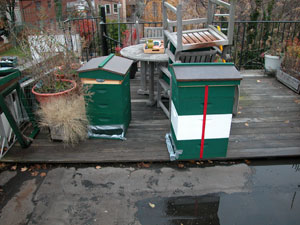 But you might be asking, what about the bees today? Well, they had to be moved onto the deck (which is not being messed with) and they had to be sealed in, because otherwise they would get lost.
But you might be asking, what about the bees today? Well, they had to be moved onto the deck (which is not being messed with) and they had to be sealed in, because otherwise they would get lost.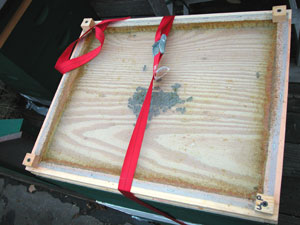 So last night, after sunset (when all the field bees should be back home) I went up and blocked the entrances with plastic window screen material and duct tape, and covered the top with a screen that is usually used for added summer ventilation. Then you run a
So last night, after sunset (when all the field bees should be back home) I went up and blocked the entrances with plastic window screen material and duct tape, and covered the top with a screen that is usually used for added summer ventilation. Then you run a 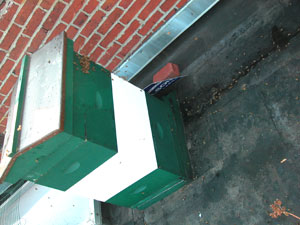 Yesterday was another feeding day, and Twain was the lucky colony... well, sort of. Remember how there seems to be a lot of bees robbing bees this year? Maybe I know why.
Yesterday was another feeding day, and Twain was the lucky colony... well, sort of. Remember how there seems to be a lot of bees robbing bees this year? Maybe I know why.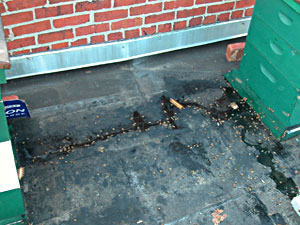 Robbing bees make a different noise than your usual buzzing, and they tend to land all over you, checking to see if perhaps YOU might be a sticky pool of undeserved sugar forming directly in front of them. It's hard to move around without crushing bees, and besides the sadness of that, crushed bee smell is a motivator to get upset: just what you don't want in the middle of a cloud of over-stimulated felon bees.
Robbing bees make a different noise than your usual buzzing, and they tend to land all over you, checking to see if perhaps YOU might be a sticky pool of undeserved sugar forming directly in front of them. It's hard to move around without crushing bees, and besides the sadness of that, crushed bee smell is a motivator to get upset: just what you don't want in the middle of a cloud of over-stimulated felon bees.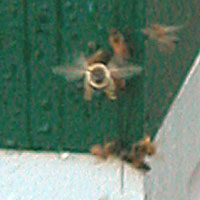 On the up side, while I was wading around the clingy bees, trying to develop a plan, I got a picture of this bee flying at me straight on. I was not trying for her picture: the camera tends to choose its own focal point, and she apparently was it. It's not great, but you can see her antenna on the left if you squint real hard.
On the up side, while I was wading around the clingy bees, trying to develop a plan, I got a picture of this bee flying at me straight on. I was not trying for her picture: the camera tends to choose its own focal point, and she apparently was it. It's not great, but you can see her antenna on the left if you squint real hard.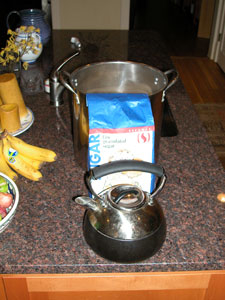 One pot, one kettle, and one ten pound bag of sugar equals a late autumn meal for one hive of bees. As the year winds down, beekeepers who want to ensure that the honeybees have enough stores for the winter mix 2 parts granulated cane sugar to one part hot water in order to make a heavy, honey-like syrup for the bees to sock away in the dwindling days left. The heavier syrup is supposed to signal to the queen that she should stop laying (if she hasn't already: some beekeepers around here say that in our climate she always lays a little through the winter) and the girls should get ready to cluster up and stay warm. By now, the drones are all gone, and things have become serious.
One pot, one kettle, and one ten pound bag of sugar equals a late autumn meal for one hive of bees. As the year winds down, beekeepers who want to ensure that the honeybees have enough stores for the winter mix 2 parts granulated cane sugar to one part hot water in order to make a heavy, honey-like syrup for the bees to sock away in the dwindling days left. The heavier syrup is supposed to signal to the queen that she should stop laying (if she hasn't already: some beekeepers around here say that in our climate she always lays a little through the winter) and the girls should get ready to cluster up and stay warm. By now, the drones are all gone, and things have become serious.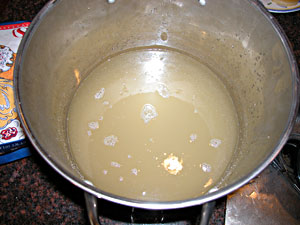 When at loose ends, I make food for the girls. This photo shows what 10 pounds of sugar looks like in about 5 pints of water, just out of the kettle. It's cloudly, and must be stirred for a while. The water must be hot to make such a super-saturated solution, and I boil it before pouring. You must never heat the sugar directly on the burner, however, because the bees cannot digest carmelized sugar and can get potentially deadly dysentery in that manner.
When at loose ends, I make food for the girls. This photo shows what 10 pounds of sugar looks like in about 5 pints of water, just out of the kettle. It's cloudly, and must be stirred for a while. The water must be hot to make such a super-saturated solution, and I boil it before pouring. You must never heat the sugar directly on the burner, however, because the bees cannot digest carmelized sugar and can get potentially deadly dysentery in that manner.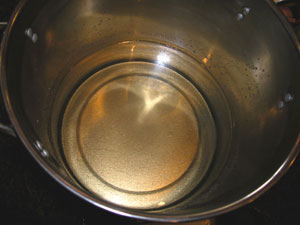 In just ten minutes or so, the mixture becomes crystal clear. It has to cool before you use it, and once it does you sometimes get little floes of sugar ice floating on the top. It helps that my counters are stone and this pot is a thin, cheap one, because I can move it around on the countertop to make it cool faster.
In just ten minutes or so, the mixture becomes crystal clear. It has to cool before you use it, and once it does you sometimes get little floes of sugar ice floating on the top. It helps that my counters are stone and this pot is a thin, cheap one, because I can move it around on the countertop to make it cool faster.